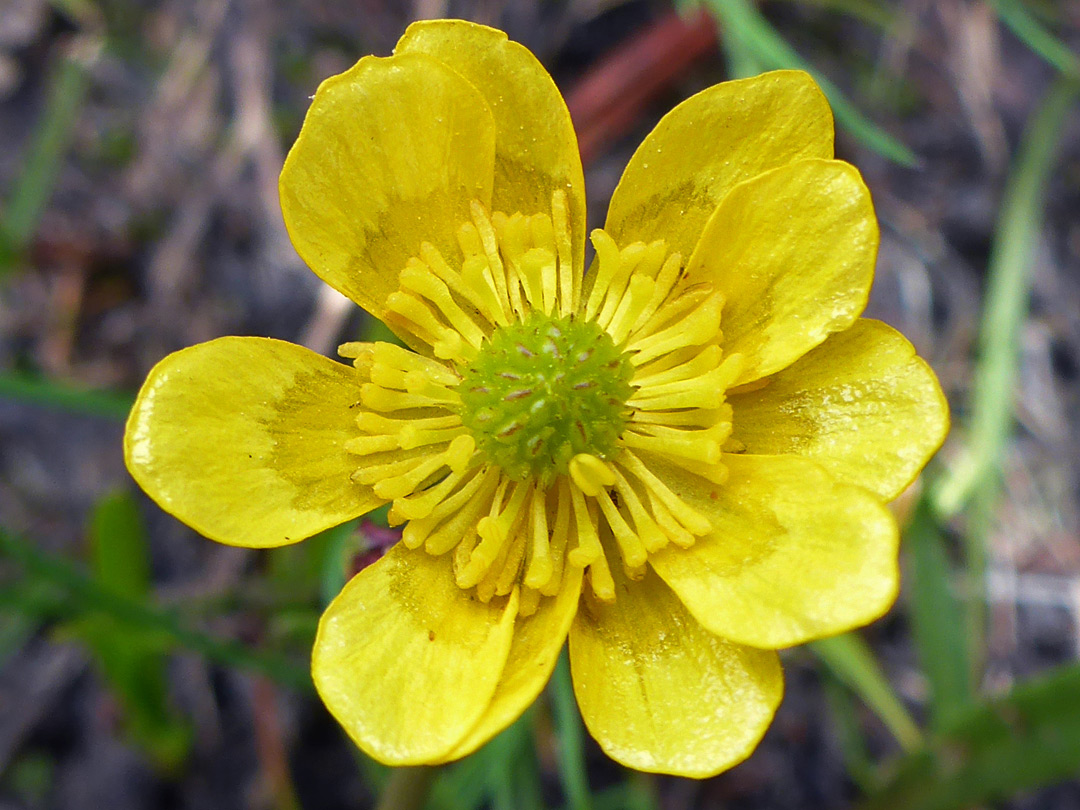| Family: Ranunculaceae | View Description | Dichotomous Key |
Common Name: BUTTERCUP FAMILY
Habit: Annual, perennial herb, woody vine [shrub], occasionally aquatic. Leaf: generally basal and cauline, alternate or opposite, simple or compound; petioles at base generally flat, occasionally sheathing or stipule-like. Inflorescence: cyme, raceme, panicle, or flowers 1. Flower: generally bisexual, generally radial; sepals 3--6(20), free, early-deciduous or withering in fruit, generally green; petals 0--many, generally free; stamens generally 5--many, staminodes generally 0; pistils 1--many, ovary superior, chamber 1, style 0--1, generally +- persistent as beak, ovules 1--many. Fruit: achene, follicle, berry, +- utricle in Trautvetteria, in aggregate or not, 1--many-seeded.
Genera In Family: +- 60 genera, 1700 species: worldwide, especially northern temperate, tropical mountains; many ornamental (Adonis, Aquilegia, Clematis, Consolida, Delphinium, Helleborus, Nigella). Toxicity: some highly TOXIC (Aconitum, Actaea, Delphinium, Ranunculus). Note: Taxa of Isopyrum in TJM (1993) moved to Enemion; Kumlienia moved to Ranunculus.
eFlora Treatment Author: Margriet Wetherwax & Dieter H. Wilken, family description, key to genera
Scientific Editor: Douglas H. Goldman, Bruce G. Baldwin.
|
| Genus: Ranunculus | View Description | Dichotomous Key |
Common Name: BUTTERCUP
Habit: Annual to perennial herb, occasionally from stolons or caudices, terrestrial or aquatic; roots generally fibrous. Stem: prostrate to erect. Leaf: basal, cauline, or both, alternate, generally reduced upward; petiole base flat, stipule-like or not; basal, proximal cauline petioles generally long; blades simple to dissected or compound, entire to toothed. Inflorescence: cyme, axillary or terminal, 1--few-flowered. Flower: sepals 3--5(6), generally early-deciduous, generally green to yellow or purple; petals 0--17[(150)], shiny, generally yellow, occasionally white or purple, nectaries near base, pocket-like or with flap-like scale; anthers yellow; pistils generally many. Fruit: achene, compressed or not, +- spheric, disk-like (width 3--15 × depth), or lenticular (width 1--2 × depth), beaked.
Species In Genus: +- 300 species: worldwide except lowland tropics; some ornamental. Etymology: (Latin: diminutive of Rana, frog, from wet habitats)
eFlora Treatment Author: Alan T. Whittemore
|
| Species: Ranunculus occidentalis | View Description |
Habit: Perennial herb 10--60 cm, not rooting at nodes. Leaf: basal, proximal cauline 1.5--5.3 cm, 2.2--8 cm wide, widely ovate to semicircular or reniform; distal cauline reduced, deeply parted or compound. Flower: receptacle glabrous; sepals 5, reflexed 2--3 mm from base, 4--7(9) mm, 2--4 mm wide, early-deciduous; petals 5--6. Fruit: disk-like, wall thick, smooth.
Note: 3 other varieties, not in California.
|
|
NATIVE
Habit: Erect to decumbent. Leaf: basal 3-parted or 1-ternate, ultimate segments oblong to elliptic, lanceolate, or oblanceolate, dentate. Flower: petals 5--10 mm, 3--6 mm wide. Fruit: body 2.6--3.6(4) mm, 1.8--3(3.2) mm wide, glabrous or bristly, beak (0.6)1--1.4 mm, curved, lanceolate.
Ecology: Grassy slopes in meadows or open woodland; Elevation:< 1500 m. Bioregional Distribution: NW, CaR, SN, CW, MP; Distribution Outside California: to British Columbia, Nevada. Flowering Time: Mar--Jul
Synonyms: Ranunculus occidentalis var. eisenii (Kellogg) A. Gray; Ranunculus occidentalis var. rattanii A. Gray
Jepson eFlora Author: Alan T. Whittemore
Index of California Plant Names (ICPN; linked via the Jepson Online Interchange)
Previous taxon: Ranunculus occidentalis var. howellii
Next taxon: Ranunculus occidentalis var. ultramontanus
| Botanical illustration including Ranunculus occidentalis var. occidentalis |
Citation for this treatment: Alan T. Whittemore 2012, Ranunculus occidentalis var. occidentalis, in Jepson Flora Project (eds.) Jepson eFlora, https://ucjeps.berkeley.edu/eflora/eflora_display.php?tid=64947, accessed on April 25, 2021. Doctor who blu ray torrent. Citation for the whole project: Jepson Flora Project (eds.) 2021, Jepson eFlora, https://ucjeps.berkeley.edu/eflora/, accessed on April 25, 2021. |
Ranunculus occidentalis var. occidentalis
© 2016 Keir Morse
| Ranunculus occidentalis var. occidentalis
© 2016 Keir Morse
| Ranunculus occidentalis var. occidentalis
© 2009 Barry Breckling
| Ranunculus occidentalis var. occidentalis
© 2009 Barry Breckling
| Ranunculus occidentalis var. occidentalis
© 2018 Barry Breckling
| Ranunculus occidentalis var. occidentalis
© 2008 Keir Morse
|
|
Geographic subdivisions for Ranunculus occidentalis var. occidentalis:
NW, CaR, SN, CW, MP | MAP CONTROLS
1. You can change the display of the base map and layers by clicking on the layer control box in the upper right-hand corner.
2. California county polygons can be turned off and on in the layer control box.
3. Filling of Jepson subdivision polygons can be turned off and on in the layer control box.
4. Moving the cursor over any numbered cluster will show the range boundary of the included specimens (with a blue polygon).
5. Marker clustering can be turned off by clicking this link: Marker Clustering OFF
WARNING: Turning this off might cause maps with large numbers of specimens to load slowly. | (Note: any qualifiers in the taxon distribution description, such as 'northern', 'southern', 'adjacent' etc., are not reflected in the map above, and in some cases indication of a taxon in a subdivision is based on a single collection or author-verified occurence).
View elevation by latitude chart
| Data provided by the participants of the Consortium of California Herbaria.
MAP LEGEND
View all CCH records
All markers link to CCH specimen records. The original determination is shown in the popup window.
Blue markers indicate specimens that map to one of the expected Jepson geographic subdivisions (see left map). Purple markers indicate specimens collected from a garden, greenhouse, or other non-wild location.
Yellow markers indicate records that may provide evidence for eFlora range revision or may have georeferencing or identification issues.
READ ABOUT YELLOW FLAGS
CCH collections by month
Duplicates counted once; synonyms included.
Species do not include records of infraspecific taxa, if there are more than 1 infraspecific taxon in CA.
Blue line denotes eFlora flowering time (fruiting time in some monocot genera). |
|

